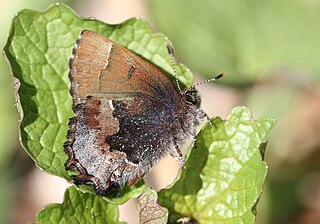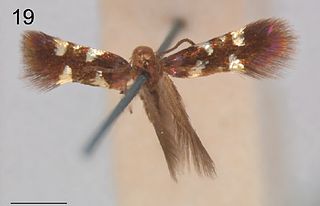
Choaspes benjaminii, also known as the Indian awlking or common awlking, is a species of butterfly in the family Hesperiidae. The species is named after Benjamin Delessert and was described on the basis of a specimen collected by Adolphe Delessert in the Nilgiris.

Curoba is a monotypic moth genus in the subfamily Arctiinae erected by Francis Walker in 1865. It contains the single species Curoba sangarida, first described by Caspar Stoll in 1782, which is found in southern India and Sri Lanka.
Asteropetes is a monotypic moth genus of the family Noctuidae erected by George Hampson in 1901. Its only species, Asteropetes noctuina, was first described by Arthur Gardiner Butler in 1878. It is found on the Kuriles and in Japan.

Callophrys henrici, the Henry's elfin or woodland elfin, is a North American butterfly in the family Lycaenidae. In Canada it is found from southern Manitoba to southern Nova Scotia. It has two main groups of populations in the United States; the first is found along the Atlantic Coast and uses various hollies (Ilex) as host plants; and the second is found mainly in the north and the Appalachians where they use redbud as a host plant. Henry's elfin is increasing in New England because of an introduced buckthorn it now uses as a host plant. It is listed as a species of special concern in the US state of Connecticut.

Estigmene acrea, the salt marsh moth or acrea moth, is a moth in the family Erebidae. The species was first described by Dru Drury in 1773. It is found in North America, and southwards from Mexico to Colombia.

Syssphinx bicolor, the honey locust moth, is a North American moth in the family Saturniidae.

Rhopobota naevana, the holly tortrix moth, holly leaf tier or blackheaded fireworm, is a moth of the family Tortricidae. It is found from Europe to eastern Russia, China, Taiwan, Mongolia, Korea and Japan. It is also present in India, Sri Lanka and North America.

Epinotia nisella is a moth of the family Tortricidae which is found in the Palearctic, Europe and North America. It was first described by Carl Alexander Clerck in 1759.

Antispila aristarcha is a moth of the family Heliozelidae. It was described by Edward Meyrick in 1916. It is found in India.
Antispila inouei is a moth of the family Heliozelidae. It was described by Kuroko in 1987. It is found in Japan.
Antispila isorrhythma is a moth of the family Heliozelidae. It was described by Edward Meyrick in 1926. It is found in India.

Holocacista salutans is a moth of the family Heliozelidae. It was described by Edward Meyrick in 1921. It is found in Zimbabwe and the South African provinces of KwaZulu-Natal and Limpopo.

Antispila uenoi is a moth of the family Heliozelidae. It was described by Kuroko in 1987. It is found in Japan. In 2018, the species was found from China.

Euchromia polymena is a species of day flying moth of the subfamily Arctiinae. These moths are vibrantly coloured and look like wasps so known as Wasp moth or Painted handmaiden moth. It was described by Carl Linnaeus in his 1758 10th edition of Systema Naturae. It is found in India and south-eastern Asia, as well as on Sumatra, Java, Sulawesi, Peninsular Malaysia, Borneo and the Philippines. It is also present in the northern part of Western Australia and the Northern Territory.

Eudesmia menea, the lunar eudesmia, is a moth of the subfamily Arctiinae. It was described by Drury in 1782. It is found from Brazil and Colombia, through Central America, to the southern United States, where it is found from southern Texas to Florida.
Epermenia philocoma is a moth in the family Epermeniidae. It was described by Edward Meyrick in 1914. It is found in India.

Holocacista capensis is a moth of the family Heliozelidae. It was described by van Nieukerken and Geertsema in 2015. It is found in South Africa.
Dichomeris condaliavorella is a moth in the family Gelechiidae. It was described by August Busck in 1900. It is found in North America, where it has been recorded from Florida.

Epinotia subocellana is a species of moth of the family Tortricidae. It is found in Asia and Europe and was first described by Edward Donovan in 1806.

Pammene splendidulana is a moth belonging to the family Tortricidae. The species was first described by Achille Guenée in 1845.















